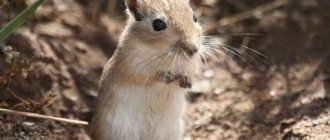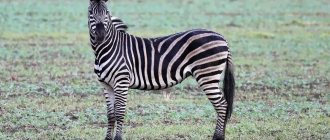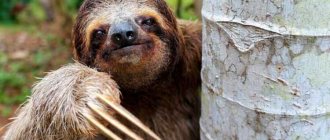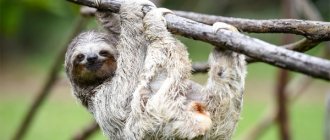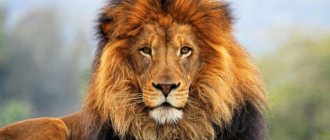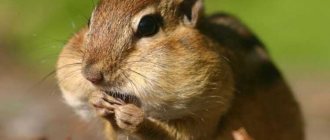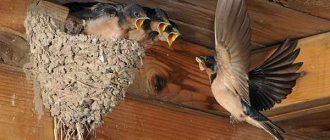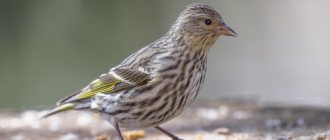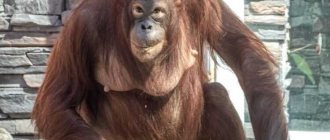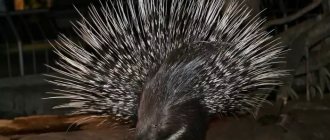Review author: “ZooVita”
Jerboas are mammals, representatives of the order of rodents. They prefer to live mainly in deserts and steppes, but their natural habitat is actually more extensive.
A distinctive feature of this amazing rodent is its large ears, thanks to which they recognize the jerboa in the photo.
General description of the animal jerboa
All representatives of this family, regardless of the subspecies in question, have a number of common characteristics. What does a jerboa look like:
- Body sizes can vary from 4 cm to 25 cm (mainly in adults).
- The head is relatively larger than the body. The shape of the head is flattened, the ears are large and slightly curved upward. This specific shape of the ears is not at all related to hearing. This structural feature contributes to greater heat transfer during rapid movement.
- Another anatomical feature is the presence of a very long tail, at the end of which there is a brush. The brush acts as a steering mechanism when the rodent runs quickly.
- Large eyes provide the animal with a proper overview of the visual angle.
- The entire body is covered with continuous hair, which retains heat on cold nights.
- The oral apparatus is represented by 18 teeth with well-developed incisors. The main purpose of the incisors is to thoroughly grind hard food (for example, grain crops) and loosen the soil during the construction of burrows.
The distinctive feature of the structure of the musculoskeletal system of the hind legs (muscles, ligaments, tendons) and the high content of myoglobin in the muscles allows the steppe rodent to develop greater speed, endurance, and dexterity. The detailed description of the jerboa varies depending on the subspecies being studied.
Interesting Facts
Jerboas are amazing creatures that have many features. It is quite difficult to study their habits in the natural environment, since rodents lead a rather secretive lifestyle.
Interesting:
- Jerboas do not need drinking water, since they obtain the required amount of liquid from the juice of plants, fruits and insects.
- Most species prefer to live alone, but during hibernation they can form groups. This helps rodents keep warm and not freeze.
- Despite their small size, jerboas are capable of reaching speeds of 30 to 40 km/h.
- Rodents navigate in the dark thanks to sensitive hearing, smell, night vision and sensitive vibrissae.
- Animals build many burrows with different purposes. This is quite unusual behavior for animals. The number of burrows can exceed several dozen.
- Jerboas have adapted to closing the entrance to their burrows with an earthen plug, which protects them from the heat and sensitive sense of smell of daytime predators.
- While running, the animals make zigzag jumps, which help them hide from predators.
- In most species, the ears are equal to or longer than the length of the muzzle. If you bend the ear forward, it will reach or cover the tip of the nose.
- The tail of the animals serves as a balancer and counterweight during sharp turns.
- Animals that inhabit the Sahara hibernate during the summer heat.
- The hind feet are covered with fur, thanks to which the animal can run on hot sand.
Jerboas are mysterious nocturnal creatures that attract the attention of scientists around the world. Even after many years since the beginning of the study, this species continues to amaze with unusual facts and interesting behavior.
Habitat and lifestyle of jerboas
An interesting question is where the jerboa lives. Rodents are distributed everywhere, including Asian countries, the European part of the continent, Altai and the banks of the Ob River. Jerboas prefer to settle in burrows, which they build themselves.
Representatives of this family are characterized by a solitary lifestyle, searching for a mate only during the breeding season.
The domestic jerboa is a favorite of families with children. It has a calm, peaceful character, but requires a careful approach to maintenance and care.
Conditions of detention
Since it is still a wild animal, the jerboa at home is very demanding in terms of arranging its habitat. Due to its energy, the animal’s cage must be rather large; a small enclosure is most suitable for it. The height of the home should be at least 50 cm, because the animal moves by jumping.
In order for the baby not to experience stress and easily adapt to the content, it is advised to recreate living conditions as close to natural as possible:
- The best option as a filler is regular sand. If desired, you can use corn filler instead, but sawdust is undesirable. From them, the rodent runs the risk of developing an allergic reaction.
- Jerboas live in burrows, so it is necessary to give them the opportunity to acquire shelter in an enclosure. For this, turf is suitable, in which the baby can dig a tunnel on his own, or offer him a clay pot that allows him to replace the hole.
- In the landscape surrounding the animal, water is not necessary; they are used to taking sand baths, but the rodent will accept plant oases with pleasure. Small twigs and leaves scattered on the sand will occupy the jerboa with its usual worries - with their help the animal will equip its nest.
You can add a couple of stones as a decorative element. The only thing that needs to be taken into account when decorating your home is that the use of plastic items is prohibited . The jerboa will definitely chew this material, so it is advisable to use natural ingredients.
Of course, a cage cannot be complete without a drinking bowl and a bowl for treats, which should be quite heavy so that the pet does not tip it over. It is advisable to refresh drinking water daily. By nature, the animals are quite clean, so changing the bedding 1-2 times a week will be enough to maintain perfect cleanliness in the enclosure.
The importance of jerboas for epidemiology
The jerboa population is subject to constant epidemiological monitoring. Research institutes monitor indicators such as numbers, migration, distribution zones, and specific disease patterns of steppe rodents.
The reason for such control is that jerboas are the main carriers of the causative agent of plague, tularemia, Q fever and a number of other zoonotic and anthroponotic diseases.
Other
Jerboas play an important role in desert biocenoses, having a significant impact on the soil and its vegetation and serving as food for many desert predators. Some jerboas cause harm by damaging plants that strengthen the sands and by eating cultivated plants; are carriers of pathogens of a number of diseases, including plague.
Jerboas have been known in fossil form since the Oligocene. The ancestors of modern jerboas likely diverged from less specialized rodents about 8 million years ago as they settled into the arid regions of Asia, from where they spread to Europe and North Africa. With the exception of Europe, where jerboas have become extinct, they still live within the boundaries of their ancient range.
Video
Jerboa feeding
Due to its small size, the jerboa requires only 55-65 grams of food to meet its daily nutrient needs. The basis of nutrition consists of seeds and plant roots, which the animal digs out from under the ground or sand. The rodent's paws with sharp claws do an excellent job of this task.
Jerboas are very fond of fruits, seeds of fruit trees and cereal crops. The larvae found during excavations also become an additional source of complete protein for the steppe inhabitants.
It should be noted that representatives of this family practically do not consume water, receiving the necessary moisture from the roots.
Other predatory insects
Rodolia
Adults and larvae burrow into the egg sacs of mature female coccids, pulling out white wax to reach the eggs below. The jaws are used to hold and chew prey.
Cryptolemus
Adults and larvae eat small insects, especially bedbugs. The jaws hold and chew prey. One larva eats 250 bedbugs before pupation. Three pairs of paws are used for walking.
Thaumatomy
The male flaps his wings to disperse pheromones from the abdominal pouches. The thorax, abdomen and edges of the eyes are bright yellow, the mesonotum has brown and yellow longitudinal stripes.
Swimming beetle
The beetles are aquatic, freely swim and dive using their hind legs, and move awkwardly on land. They breathe underwater with air that is collected and stored directly under the elytra.
Types of jerboas
Today, there are about 25 species of jerboas, different in their external structure and way of life. The most famous species of steppe inhabitants:
Five-toed pygmy jerboa
According to its interesting name, the representative of the subspecies is very small in size, reaching a length of 7.5 cm. A distinctive feature is the original structure of the tail, with several narrowings and expansions. Lives exclusively in the deserts of China and Mongolia.
Hairy jerboa
The rodent's paws have an abundant fluffy covering. There is a brush border on the soles, with the help of which the animal quickly moves along the sand.
Egyptian jerboa
A distinctive feature is the well-developed muscles of the hind limbs, thanks to which the jerboa can jump to a height of up to 1 meter and a length of 2-3 meters.
Ground hare
A representative of the rodent family, distinguished by its largest size. It lives mainly in southeast Asia and Europe. The marsupial species of jerboas is now considered endangered due to mass extermination. The habitat is limited exclusively to the territory of Australia.
The long-eared jerboa, which got its name because of its incredibly long ears and narrow muzzle.
The Mexican jerboa deserves special attention, its fur is highly valued in the production of fur coats and trims for outerwear. It was the extermination of the Mexican jerboa that caused a significant reduction in the natural population.
Enemies of jerboas in the wild
Wide habitat, small size - both of these factors contribute to the appearance of numerous enemies among jerboas.
Birds of prey (hawks, falcons), reptiles (snakes and large lizards), as well as ground hunters (foxes, martens, stoats) are not averse to feasting on young animals. To protect themselves from enemy attacks, jerboas dig deep and winding burrows.
The advantage is the fact that the animals are excellent builders. Also having sensitive ears, a well-developed sense of vision and touch, jerboas quickly react to the slightest vibrations in the air and the approach of predators.
Big-eared fox
Where: AfricaAlso known as the long-eared fox, this species of fox has large ears. The fox has extremely sharp teeth, allowing it to chew its food quickly and efficiently to aid digestion. They feed on insects, small invertebrates, small birds, mammals and reptiles, and desert tortoises. You can find them in pairs or groups in short grasslands and dry areas of the savannah.
This is interesting: Terrestrial or land animals: characteristics, signs and examples
Reproduction of jerboas
The metabolism of steppe animals involves rapid growth and puberty, which occurs at the 7th month of life. In one year, females are able to bear two or three litters of young animals.
For childbirth and nursing of young offspring, jerboas dig a separate burrow, with long winding passages (additional protection from predators). Young jerboas bear little resemblance to an adult rodent. The young are practically hairless and completely blind at birth.
Jerboas have a peculiarity in raising young animals. The female raises the cubs until they are 3 months old. After this period, signs of pronounced aggression appear in the mother’s behavior, which is a signal for the jerboas to live independently.
Diet
When purchasing such an exotic animal, the new owner does not always have an idea of what the jerboa eats . In fact, his diet is very varied, and it will not be difficult to choose a nutrition plan for this fidget. He eats both plant and animal foods. So, what to feed the jerboa at home?
- The basis of the diet must be a grain mixture for rodents, which is dominated by wheat, oats, millet and barley. For variety, different seeds are suitable, for example, sunflower and pumpkin.
- Fruits and vegetables must be present in the animal’s diet. Without fear, your baby can be given fresh apples, carrots and cabbage. It is best not to offer exotic fruits.
- Protein foods of animal origin include mealworms, crickets and grasshoppers. It is permissible to add boiled finely chopped meat, low-fat cottage cheese and a boiled egg to the baby’s diet.
It is forbidden to feed your ornamental pet food prepared for humans, because spices, salt and sugar are contraindicated for these animals. Seafood is also not suitable for animals. The food offered to the jerboa should always be fresh.
